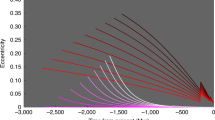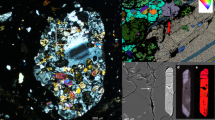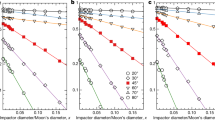Abstract
All of the gas giants in our Solar System host ring systems, in contrast to the inner planets. One proposed mechanism of planetary ring formation is disruption or mass shedding of moons. The orbit of Phobos, the larger of Mars’s two moonlets, is gradually spiralling inwards towards Mars and the moon is experiencing increasing tidal stresses. Eventually, Phobos will either break apart to form a ring or it will crash into Mars. We evaluate these outcomes based on geologic, spectral and theoretical constraints, in conjunction with a geotechnical model that helps us determine the strength of Phobos. Our analysis suggests that much of Phobos is composed of weak, heavily damaged materials. We suggest that—with continued inward migration of the moon—the weakest material will disperse tidally in 20 to 40 million years to form a Martian ring. We predict that this ring will persist for 106 to 108 years and will initially have a comparable mass density to that of Saturn’s rings. Any large fragment of Phobos that is strong enough to escape tidal breakup will eventually collide with Mars in an oblique, low-velocity impact. Our analysis of the evolution of Phobos underscores the potential orbital and topographic consequences of the growth and self-destruction of other inwardly migrating moons, including those that met their demise early in our Solar System’s history.
This is a preview of subscription content, access via your institution
Access options
Subscribe to this journal
Receive 12 print issues and online access
$259.00 per year
only $21.58 per issue
Buy this article
- Purchase on Springer Link
- Instant access to full article PDF
Prices may be subject to local taxes which are calculated during checkout



Similar content being viewed by others
References
Murray, C. D. & Dermott, S. F. Solar System Dynamics (Cambridge Univ. Press, 1999).
Canup, R. M. & Asphaug, E. Origin of the Moon in a giant impact near the end of the Earth’s formation. Nature 412, 708–712 (2001).
Goldreich, P. & Soter, S. Q in the Solar System. Icarus 5, 375–389 (1966).
Veverka, J. & Burns, J. A. The moons of Mars. Annu. Rev. Earth Planet. Sci. 8, 527–558 (1980).
Soter, S. & Harris, A. Are striations on Phobos evidence for tidal stress? Nature 268, 421–422 (1977).
Mignard, F. Evolution of the Martian satellites. Mon. Not. R. Astron. Soc. 194, 365–379 (1981).
Szeto, A. M. Orbital evolution and origin of the Martian satellites. Icarus 55, 133–168 (1983).
Bills, B. G., Neumann, G. A., Smith, D. E. & Zuber, M. T. Improved estimate of tidal dissipation within Mars from MOLA observations of the shadow of Phobos. J. Geophys. Res. 110, E07004 (2005).
Jacobson, R. A. The orbits and masses of the Martian satellites and the libration of Phobos. Astron. J. 139, 668–679 (2010).
Burns, J. A. Where are the satellites of the inner planets? Nature 242, 23–25 (1973).
Chappelow, J. & Herrick, R. On the origin of a double, oblique impact on Mars. Icarus 197, 452–457 (2008).
Canup, R. M. Origin of Saturn’s rings and inner moons by mass removal from a lost Titan-sized satellite. Nature 468, 943–926 (2010).
Pätzold, M., Andert, T., Jacobson, R., Rosenblatt, P. & Dehant, V. Phobos: Observed bulk properties. Planet. Space Sci. 102, 86–94 (2014).
Nimmo, F. & Faul, U. Dissipation at tidal and seismic frequencies in a melt-free, anhydrous Mars. J. Geophys. Res. 118, 2558–2569 (2013).
Holsapple, K. A. & Michel, P. Tidal Disruptions: II. A continuum theory for solid bodies with strength, with applications to the solar system. Icarus 193, 283–301 (2008).
Fraeman, A. et al. Analysis of disk-resolved OMEGA and CRISM spectral observations of Phobos and Deimos. J. Geophys. Res. 117, E00J15 (2012).
Rubin, A. E., Trigo-Rodríguez, J. M., Huber, H. & Wasson, J. T. Progressive aqueous alteration of CM carbonaceous chondrites. Geochim. Cosmochim. Acta 71, 2361–2382 (2007).
Willner, K., Shi, X. & Oberst, J. Phobos’ shape and topography models. Planet. Space Sci. 102, 51–59 (2014).
Richardson, D., Leinhardt, Z., Melosh, H., Bottke, W. Jr & Asphaug, E. Gravitational aggregates: Evidence and evolution. Asteroids III 1, 501–515 (2002).
Willner, K. et al. Phobos control point network, rotation, and shape. Earth Planet. Sci. Lett. 294, 541–546 (2010).
Asphaug, E. & Melosh, H. The Stickney impact of Phobos: A dynamical model. Icarus 101, 144–164 (1993).
Asphaug, E., Ostro, S., Hudson, R., Scheeres, D. & Benz, W. Disruption of kilometre-sized asteroids by energetic collisions. Nature 393, 437–440 (1998).
Rovny, J., Owen, J. M., Howley, K. & Wasem, J. in Proc. 44th Lunar Planet. Sci. Conf. 2013 1076 (LPI, 2013).
Hoek, E. & Brown, E. Practical estimates of rock mass strength. Int. J. Rock Mech. Min. Sci. 34, 1165–1186 (1997).
Hoek, E., Carranza-Torres, C. & Corkum, B. Hoek–Brown failure criterion-2002 edition. Proc. NARMS-Tac 1, 267–273 (2002).
Brown, P. G., Revelle, D. O., Tagliaferri, E. & Hildebrand, A. R. An entry model for the Tagish Lake fireball using seismic, satellite and infrasound records. Meteorit. Planet. Sci. 37, 661–675 (2002).
Colmenares, L. & Zoback, M. A statistical evaluation of intact rock failure criteria constrained by polyaxial test data for five different rocks. Int. J. Rock Mech. Min. Sci. 39, 695–729 (2002).
Leinhardt, Z. M., Ogilvie, G. I., Latter, H. N. & Kokubo, E. Tidal disruption of satellites and formation of narrow rings. Mon. Not. R. Astron. Soc. 424, 1419–1431 (2012).
Colwell, J. et al. Saturn from Cassini–Huygens (eds Dougherty, M. K., Esposito, L. W. & Krimigis, S. M.) 375–412 (Springer, 2009).
Goldreich, P. & Tremaine, S. Disk–satellite interactions. Astrophys. J. 241, 425–441 (1980).
JeongAhn, Y. & Malhotra, R. The current impact flux on Mars and its seasonal variation. Icarus 262, 140–153 (2015).
Beech, M. Towards an understanding of the fall circumstances of the Hoba meteorite. Earth Moon Planets 111, 15–30 (2013).
Lee, P. et al. in Proc. 46th Lunar Planet. Sci. Conf. 2015 2856 (LPI, 2015).
Raymond, C., Prettyman, T. & Diniega, S. in Proc. 46th Lunar Planet. Sci. Conf. 2015 2792 (LPI, 2015).
Murchie, S. et al. in Proc. 46th Lunar Planet. Sci. Conf. 2015 2047 (LPI, 2015).
Kokubo, E. & Genda, H. Formation of terrestrial planets from protoplanets under a realistic accretion condition. Astrophys. J. Lett. 714, L21 (2010).
Raymond, S. N., Kokubo, E., Morbidelli, A., Morishima, R. & Walsh, K. J. in Protostars and Planets VI (eds Beuther, H. et al.) 595–618 (Univ. Arizona, Tucson, 2014).
Schofield, J. T. et al. The Mars Pathfinder atmospheric structure investigation/meteorology (ASI/MET) experiment. Science 278, 1752–1758 (1997).
Collins, G., Elbeshausen, D., Davison, T., Robbins, S. & Hynek, B. The size-frequency distribution of elliptical impact craters. Earth Planet. Sci. Lett. 310, 1–8 (2011).
Taylor, P. A. & Margot, J.-L. Tidal evolution of close binary asteroid systems. Celest. Mech. Dyn. Astron. 108, 315–338 (2010).
Goldreichand, P. & Gold, T. On the eccentricity of satellite orbits in the solar system. Mon. Not. R. Astron. Soc. 126, 257–268 (1963).
Rosenblatt, P. & Charnoz, S. On the formation of the Martian moons from a circum-Martian accretion disk. Icarus 221, 806–815 (2012).
Efroimsky, M. & Lainey, V. Physics of bodily tides in terrestrial planets and the appropriate scales of dynamical evolution. J. Geophys. Res. 112, E12003 (2007).
Auclair-Desrotour, P., Le Poncin-Lafitte, C. & Mathis, S. Impact of the frequency dependence of tidal Q on the evolution of planetary systems. Astron. Astrophys. 561, L7 (2014).
Yokoyama, T., Mana, M. R., Do Nascimento, C., Santos, M. T. & Callegari, N. Jr On the dynamics of some resonances of Phobos in the future. Astron. Astrophys. 429, 731–738 (2005).
Yokoyama, T. Possible effects of secular resonances in Phobos and Triton. Planet. Space Sci. 50, 63–77 (2002).
Peale, S. J. & Cassen, P. Contribution of tidal dissipation to lunar thermal history. Icarus 36, 245–269 (1978).
Peale, S. J., Cassen, P. & Reynolds, R. T. Melting of Io by tidal dissipation. Science 203, 892–894 (1979).
Wisdom, J. Spin–orbit secondary resonance dynamics of Enceladus. Astron. J. 128, 484–491 (2004).
Goldreich, P. & Sari, R. Tidal evolution of rubble piles. Astrophys. J. 691, 54–60 (2009).
Le Maistre, S. et al. Phobos interior from librations determination using Doppler and star tracker measurements. Planet. Space Sci. 85, 106–122 (2013).
Holsapple, K. A. Equilibrium configurations of solid cohesionless bodies. Icarus 154, 432–448 (2001).
Holsapple, K. A. & Michel, P. Tidal disruptions: A continuum theory for solid bodies. Icarus 183, 331–348 (2006).
Hoek, E. Estimating Mohr–Coulomb friction and cohesion values from the Hoek–Brown failure criterion. Int. J. Rock Mech. Min. Sci. Geomech. Abstr. 27, 227–229 (1990).
Holsapple, K. A. On the “strength” of the small bodies of the solar system: A review of strength theories and their implementation for analyses of impact disruptions. Planet. Space Sci. 57, 127–141 (2009).
Eberhardt, E. The Hoek–Brown Failure Criterion. The ISRM Suggested Methods for Rock Characterization, Testing and Monitoring 2007–2014 233–240 (Springer, 2015).
Klimczak, C., Byrne, P. K. & Solomon, S. C. A rock-mechanical assessment of Mercury’s global tectonic fabric. Earth Planet. Sci. Lett. 416, 82–90 (2015).
Watters, T. R., Thomas, P. C. & Robinson, M. S. Thrust faults and the near-surface strength of asteroid 433 Eros. Geophys. Res. Lett. 38, L02202 (2011).
Williams, N., Watters, T, Pritchard, M., Banks, M. & Bell, J. Faults dislocation modeled structure of lobate scarps from Lunar Reconnaissance Orbiter Camera digital terrain models. J. Geophys. Res.: Planets 118, 224–233 (2013).
Jutzi, M. Sph calculations of asteroid disruptions: The role of pressure dependent failure models. Planet. Space Sci. 107, 3–9 (2015).
Mitchell, J. K., Bromwell, L. G., Carrier III, W. D., Costes, N. C. & Scott, J. F. Soil mechanical properties at the Apollo 14 site. J. Geophys. Res. 77, 5641–5664 (1972).
Lambe, T. W. & Whitman, R. V. Soil Mechanics SI Version (John Wiley, 2008).
Hoek, E. Practical Rock Engineering (2000); www.rocscience.com
Cai, M. Practical estimates of tensile strength and Hoek–Brown strength parameter m i of brittle rocks. Rock Mech. Rock Eng. 43, 167–184 (2010).
Marinos, V., Marinos, P. & Hoek, E. The geological strength index: Applications and limitations. Bull. Eng. Geol. Environ. 64, 55–65 (2005).
Pajola, M. et al. Phobos as a d-type captured asteroid, spectral modeling from 0.25 to 4.0 μm. Astrophys. J. 777, 127 (2013).
Tomeoka, K. & Buseck, P. R. Indicators of aqueous alteration in cm carbonaceous chondrites: Microtextures of a layered mineral containing Fe, S, O and Ni. Geochim. Cosmochim. Acta 49, 2149–2163 (1985).
Fraeman, A. A. et al. Spectral absorptions on Phobos and Deimos in the visible/near infrared wavelengths and their compositional constraints. Icarus 229, 196–205 (2014).
Hunten, D. M. Capture of Phobos and Deimos by photoatmospheric drag. Icarus 37, 113–123 (1979).
Burns, J. A. Contradictory clues as to the origin of the Martian moons. Mars 1, 1283–1301 (1992).
Andert, T. P. et al. Precise mass determination and the nature of Phobos. Geophys. Res. Lett. 37, L09202 (2010).
Citron, R. I., Genda, H. & Ida, S. Formation of Phobos and Deimos via a giant impact. Icarus 252, 334–338 (2015).
Fanale, F. P. & Salvail, J. R. The influence of CO ice on the activity and near-surface differentiation of comet nuclei. Icarus 84, 403–413 (1990).
Popova, O. et al. Very low strengths of interplanetary meteoroids and small asteroids. Meteorit. Planet. Sci. 46, 1525–1550 (2011).
Brown, P. G. et al. The fall, recovery, orbit, and composition of the Tagish Lake meteorite: A new type of carbonaceous chondrite. Science 290, 320–325 (2000).
Hildebrand, A. R. et al. The fall and recovery of the Tagish Lake meteorite. Meteorit. Planet. Sci. 41, 407–431 (2006).
Bažant, Z. P, Kim, J.-J. H., Daniel, I. M., Becq-Giraudon, E. & Zi, G. Size effect on compression strength of fiber composites failing by kink band propagation. Int. J. Fract. 95, 103–141 (1999).
Sharma, I. The equilibrium of rubble-pile satellites: The Darwin and Roche ellipsoids for gravitationally held granular aggregates. Icarus 200, 636–654 (2009).
Dobrovolskis, A. R. Internal stresses in Phobos and other triaxial bodies. Icarus 52, 136–148 (1982).
Alejano, L. R. & Bobet, A. Drucker–Prager criterion. Rock Mech. Rock Eng. 45, 995–999 (2012).
Veras, D., Leinhardt, Z. M., Bonsor, A. & Gänsicke, B. T. Formation of planetary debris discs around white dwarfs—i. Tidal disruption of an extremely eccentric asteroid. Mon. Not. R. Astron. Soc. 445, 2244–2255 (2014).
Lynden-Bell, D. & Pringle, J. E. The evolution of viscous discs and the origin of the nebular variables. Mon. Not. R. Astron. Soc. 168, 603–637 (1974).
Goldreich, P. & Tremaine, S. The velocity dispersion in Saturn’s rings. Icarus 34, 227–239 (1978).
Esposito, L. W. Composition, structure, dynamics, and evolution of Saturn’s rings. Annu. Rev. Earth Planet. Sci. 38, 383–410 (2010).
Toomre, A. On the gravitational stability of a disk of stars. Astrophys. J. 139, 1217–1238 (1964).
Salo, H. Simulations of dense planetary rings III. Self-gravitating identical particles. Icarus 117, 287–312 (1995).
Daisaka, H. & Ida, S. Spatial structure and coherent motion in dense planetary rings induced by self-gravitational instability. Earth Planets Space 51, 1195–1213 (1999).
Salo, H., Schmidt, J. & Spahn, F. Viscous overstability in Saturn’s B ring: I. Direct simulations and measurement of transport coefficients. Icarus 153, 295–315 (2001).
Yasui, Y., Ohtsuki, K. & Daisaka, H. Viscosity in planetary rings with spinning self-gravitating particles. Astron. J. 143, 110 (2012).
Shukhman, I. G. Collisional dynamics of particles in Saturn’s rings. Sov. Astron. 28, 574–585 (1984).
Shu, F. H. & Stewart, G. R. The collisional dynamics of particulate disks. Icarus 62, 360–383 (1985).
Morishima, R. & Salo, H. Simulations of dense planetary rings: IV. Spinning self-gravitating particles with size distribution. Icarus 181, 272–291 (2006).
Salmon, J., Charnoz, S., Crida, A. & Brahic, A. Long-term and large-scale viscous evolution of dense planetary rings. Icarus 209, 771–785 (2010).
Dougherty, M., Esposito, L. & Krimigis, S. Saturn from Cassini–Huygens (Springer Science and Business Media, 2009).
Hedman, M. M. & Nicholson, P. D. Kronoseismology: Using density waves in Saturn’s C ring to probe the planet’s interior. Astron. J. 146, 12 (2013).
Hahn, J. M. & Spitale, J. N. An n-body integrator for gravitating planetary rings, and the outer edge of Saturn’s B ring. Astrophys. J. 772, 122 (2013).
Nicholson, P. D., French, R. G., Hedman, M. M., Marouf, E. A. & Colwell, J. E. Noncircular features in Saturn’s rings I: The edge of the B ring. Icarus 227, 152–175 (2014).
Beech, M. Electrophonic sound generation by the Chelyabinsk fireball. Earth Moon Planets 113, 33–41 (2014).
Pollack, J. B. & Burns, J. A. An origin by capture for the Martian satellites? Bull. Am. Astron. Soc. 9, 518 (1977).
Peale, S. J. & Canup, R. M. Treatise on Geophysics 2nd edn, 559–604 (Elsevier, 2015).
Schultz, P. H. & Lutz-Garihan, A. B. Grazing impacts on Mars: A record of lost satellites. J. Geophys. Res. 87, A84–A96 (1982).
Robbins, S. J. & Hynek, B. M. A new global database of Mars impact craters ≤ 1 km: 1. Database creation, properties, and parameters. J. Geophys. Res. 117, E06001 (2012).
Acknowledgements
B.A.B. thanks the Open Earth Systems project funded by National Science Foundation grant EAR-1135382. K. Ferrier, B. Marsh, H. Lenferink, B. Buffett, R. Citron and M. Manga provided valuable feedback on earlier versions of this work. The authors gratefully acknowledge the support of M. Manga.
Author information
Authors and Affiliations
Contributions
B.A.B. and T.M. jointly planned the research, performed the calculations, and wrote and revised the manuscript.
Corresponding authors
Ethics declarations
Competing interests
The authors declare no competing financial interests.
Supplementary information
Supplementary Information
Supplementary Information (PDF 475 kb)
Rights and permissions
About this article
Cite this article
Black, B., Mittal, T. The demise of Phobos and development of a Martian ring system. Nature Geosci 8, 913–917 (2015). https://doi.org/10.1038/ngeo2583
Received:
Accepted:
Published:
Issue Date:
DOI: https://doi.org/10.1038/ngeo2583
This article is cited by
-
Dynamical evidence for Phobos and Deimos as remnants of a disrupted common progenitor
Nature Astronomy (2021)
-
The rheology and thermal history of Mars revealed by the orbital evolution of Phobos
Nature (2019)
-
The ABCs of Viewing Ringed Planets
The Mathematical Intelligencer (2018)
-
An ongoing satellite–ring cycle of Mars and the origins of Phobos and Deimos
Nature Geoscience (2017)
-
Accretion of Phobos and Deimos in an extended debris disc stirred by transient moons
Nature Geoscience (2016)




